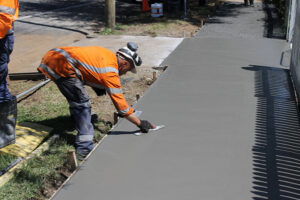Weather can sometimes get pretty hectic. In one moment, the weather is moderate and fairly neutral overall, and in the next moment, the temperature can take a nosedive. As the temperatures get lower, concrete slabs become especially vulnerable. Concrete can be cracked more easily, and it’s more likely that your slabs will deteriorate. You want to know what to expect when the weather turns bitterly cold. Here is how cold weather can do damage to concrete.
About Cold Temperatures
There are some days when winter weather is so brutal that the temperatures can dip into the single digits or even below zero! But it doesn’t even take weather getting that cold to do serious damage to concrete. For concrete, it has to worry if the following is true about the weather for at least three days.
- The air temperature goes under 40 degrees Fahrenheit on average.
- The air temperature is under 50 degrees Fahrenheit for at least one half of a 24-hour time period.
So what makes cold weather such a problem for new concrete? Whenever cement is curing, there is a process known as hydration that takes place. During hydration, crystals inside of the mixture grow, which helps strengthen the concrete. Slowing down this process doesn’t allow it to strengthen as much, and hydration becomes slower as temperatures go down. Cold concrete isn’t able to create enough crystals to reach appropriate durability.
Freeze-And-Thaw Cycles
If you don’t know what a freeze-and-thaw cycle is, it’s what happens whenever water freezes, causing it to expand, then thaws, returning it to the way it was.
Above the Cement
It’s possible that you already have a slab that’s perfectly cured, reaching the necessary strength. However, your slabs can sometimes have small holes in them, and these holes can cause trouble. Concrete, despite being sturdy, is absorbent, meaning water can get into it and get underneath the surface if there are holes that allow it. Once water penetrates your slab, it’s only a matter of time until cold weather causes that water to expand within the slab and weaken it gradually over time. Eventually, it will cause the concrete to completely deteriorate.
Below the Cement
Freeze-and-thaw cycles can also harm the ground that’s just underneath pathways and concrete pads. This is a result of sites not getting drained prior to getting concrete cured. If there is already water in the soil, it can freeze and cause slabs to be pushed up.
It doesn’t take many cycles to cause damage. All it takes is a round of bitter weather or two, and everything can go wrong. What’s worse is that people use salt to get rid of ice from concrete, which actually accelerates how quickly it takes damage since water will then freeze at a lower temperature.
Concrete Visions Will Get The Job Done Right
Concrete Visions has been working with clients for over 25 years. Our G&M Services installers are certified with the industry’s major firestop product manufacturers. As part of our firestop service, we can assess abnormal field conditions and, with the manufacturer’s technical support assistance, provide engineering judgments in a timely fashion to comply with contract specifications. Our Field Mechanics undergo ongoing training, including mandatory monthly safety meetings, weekly Toolbox Talks where safety and equipment information is shred, and trainings on safe work standards and safety best practices.

